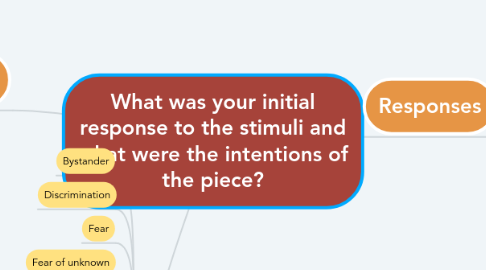
1. Intentions
1.1. Create a moving piece in order to show the audience what needs to change.
1.2. Reveal the problems with today's society.
1.3. Get the audience thinking.
1.4. Include themes like; turning a blind eye, ignorance, discrimination.
2. Themes
2.1. Bystander
2.2. Discrimination
2.3. Fear
2.4. Fear of unknown
2.5. Forgotten citizens
2.6. Ignorance
2.7. Narrow-mindedness
2.8. Negligence
2.9. Power
2.10. Prejudice
2.11. Price of human life
2.12. Social injustice
2.13. Turning a blind eye
3. Responses
3.1. Stimulus 3-Aberfan
3.1.1. Thoughts
3.1.1.1. People turned a blind eye to the consequences. Some people actually knew what could happen, but they decided that it wouldn't happen. This was a mistake.
3.1.1.2. Ignorance. They ignored the warnings.
3.1.1.3. Cost of human life. Did they even calculate the costs and benefits? People died unnecessarily. You can't put a value on a human life.
3.2. Stimulus 2-Blind Eyes
3.2.1. Thoughts
3.2.1.1. Ignorance. People do not care about what is happening. They choose to forget it.
3.2.1.2. Psychological. The more people around, the less likely it is that someone will help. This is because people follow what the majority of people do. It's like a type of flocking. But some break that mould and help.
3.2.1.3. People are only looking after themselves.
3.2.1.4. People need to pay more attention. If people are more attentive, then less people would be hurt. And more people would be helped.
3.3. Stimulus 1-Keep your coins i want change.
3.3.1. Thoughts
3.3.1.1. Politics. Many reasons why people become homeless come down to the fact that the government doesn't care about what happens to those in worse positions than themselves.
3.3.1.2. Inequality. Some people have a worse life. Less pay, bad job, bad education or just being different. Usually it is not the person's own fault.
3.3.1.3. Homeless. The man clearly has no roof to put over his head. and he is asking for what, at first, seems to be money.
3.3.1.4. Sympathy. People feel sympathy for the man because he is worse of than them.
3.3.1.5. Word play. Change can mean both money and making a difference.
3.3.1.6. Double entendre. There are two types of change.
3.3.1.7. Societies mistakes: all society cares about is money. Not about changing the world for the better. Most people are self-centred.
3.3.1.8. He is painted in white on a black background. White is normally associated with innocence and hope. And black means death and despair. This creates contrast.

